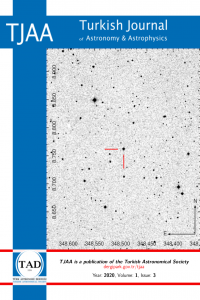Abstract
Chromospherically active binaries (CABs) are detached binary systems with cool components characterized by strong chro- mospheric, transistion region, and coronal activity. This study presents a deatiled survey of the extended/circumstellar matter around chromospherically active binary systems by examining the colour excess (CE) observations of selected 14 chromo¬spherically active and total eclipsing binary systems (LX Per, SV Cam, W Mon, SS Cam, GK Hya, RW Uma, UX Com, RS CVn, SS Boo, PW Her, AW Her, RT Lac, AR Lac and RT And). For colour excess measurements, the colour observations of these 14 binaries together with 28 inactive reference stars of similar spectral types and luminosity classes of the components of these 14 CABs, have been obtained by using new Johnson- Cousins BVRcIc, 2MASS, and WISE photometric systems. The photometric CCD observations of selected 14 CABs and 28 ref-erence stars were carried out by using the instrumental setups of the T100 telescope system of TÜBİTAK National Observa- tory (TUG) and the T40 telescope system of Ankara University Kreiken Observatory (AUKR) during the period 2012 - 2014. In addition, with the aim of having some supportive spectral data, some spectra of reference stars and AR Lac binary system, were taken by TFOSC and Coude Echelle Cameras attached to TUG RTT150 telescope.
Fekel et al. (1986) indicate that chromospherically active stars have colour excesses in (V-R) and in (V-I) by using their photometric observations of 52 late-type stars. Busso et al. (1990)) have studied the infrared emission of active binaries and they concluded that about 40% of RS CVn type binary systems exhibit infrared excess. A survey for extended matter has been presented by Hall & Ramsey (1992) to determine the frequency and nature of circumstellar matter in CABs. Scaltriti et al. (1993) have analysed the energy distributions of 12 RS CVn type binaries and they also confirmed that the circumstellar matter around CABs is clearly present.
The best way to determine the presence of a possible cir-cumstellar disk/matter in CABs is to find out whether the ex- cess radiations are phase-dependent or not, and whether the excess radiation have variation depending on the phase or not. In addition, the excess radiation to be found by comparing the spectral energy distribution (SED) during primary/secondary minima of an active binary system with the SED of a reference star of the same (B — V)◦ provides evidence of the presence of a circumstellar disk/matter in this active binary system.
The CE values at around primary/secondary minima and outside eclipses have been examined to check the existence of extended matter around an active binary component(s) of 14 CABs of this study. The results of these CEs, especially during primary minima with those at secondary minima and outside eclipses, showed that these systems have greater excess radi- ation in primary minima than in both secondary minima and outside eclipses. It was found that the colour excesses, in gen¬eral, most likely arise from the extended matter around the cooler component of a binary system. The comparison of CE values also showed that the extended matter of some of these systems had most likely covered or affected both of their com¬ponents. Since the light curve obtained by the photometric data of the SS Cam active binary systems does not show a consistent distribution, the SS Cam binary system could not be included in the evaluation. Also, since no observational data was obtained during primary minimum of RW UMa, this bi¬nary system had to be excluded in examination of the locations of primary components on HR diagram together with corre- sponding evolutionary tracks. With remaining 12 systems of this study, an examination of the locations of cool and active components on HR diagram together with corresponding evo- lutionary tracks showed that most of the active binary systems have an extended matter caused not only from stellar activity but also more likely caused from evolutionary processes.
References
- Busso, M., Scaltriti, F., Ferrari-Toniolo, M., Origlia, L., Persi, P., Robberto, M., Silvestro, G.: Mem. Soc. Astron. Italiana 61 (1990) 77-81
- Fekel F.G., Moffet, T. J., Henry, G.G.: ApJS 60 (1986) 551-576
- Hall, J.C., Ramsey, L.W.: AJ 104(1992) 1942-1960
- Scaltriti, F., Busso, M., Ferrari-Toniolo, M., Origlia, L., Persi, P., Robberto, M., Silvetsro, G.: MNRAS 264 (1993) 5-15
Abstract
References
- Busso, M., Scaltriti, F., Ferrari-Toniolo, M., Origlia, L., Persi, P., Robberto, M., Silvestro, G.: Mem. Soc. Astron. Italiana 61 (1990) 77-81
- Fekel F.G., Moffet, T. J., Henry, G.G.: ApJS 60 (1986) 551-576
- Hall, J.C., Ramsey, L.W.: AJ 104(1992) 1942-1960
- Scaltriti, F., Busso, M., Ferrari-Toniolo, M., Origlia, L., Persi, P., Robberto, M., Silvetsro, G.: MNRAS 264 (1993) 5-15
Details
| Primary Language | English |
|---|---|
| Subjects | Astronomical Sciences (Other) |
| Journal Section | Dissertation |
| Authors | |
| Publication Date | December 31, 2020 |
| Submission Date | December 25, 2020 |
| Acceptance Date | December 25, 2020 |
| Published in Issue | Year 2020 Volume: 1 Issue: 3 |
TJAA is a publication of Turkish Astronomical Society (TAD).

